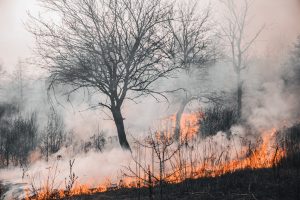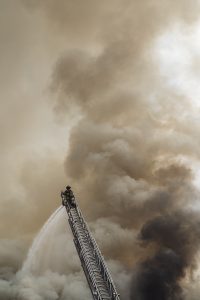
Smoke & Soot: The Dangerous Byproduct of Wildfire Season
Summer, AKA fire season in water-deprived California is here and from the looks of it, it is going to be a lot like last year’s record-setting season. This is concerning not only for those with property in fire-prone areas but nearly every property in the state due to the extensive reach of smoke and soot.
While wildfires are dangerous themselves, the smoke and soot produced from these fires can impact properties far beyond the reach of the flames. Before you can understand how to prevent damages from these byproducts of fire, it is important to understand what smoke and soot actually are.
 What is Soot?
What is Soot?
Soot is the black substance that is created following the combustion process of a fire. It is made up of mostly amorphous carbon, produced by the incomplete burning of an object.
Fine particles of soot can travel, clinging to surfaces such as walls and ceilings. When present, these toxic particles can also enter your body through inhalation causing an array of health issues.
Potential Dangers
The longer an individual or building is exposed to smoke and soot, the more these particles can absorb into its surroundings, increasing its impact on a property its occupants. When smoke absorbs into a surface, the chemicals that were released from the burning materials will transfer to the affected structure. These chemicals have toxic properties which increase danger levels much more than just burning wood.
The damage correlated with smoke and soot in buildings includes permanent discoloration in floors, fabrics, and any porous material. Smoke and soot can also damage the more expensive materials such as metals and glass and could potentially impact the overall structure of your property if left untreated.
When released into the air, toxic smoke can be inhaled causing problems in an individual’s lungs. These problems may include aggravated asthma, bronchitis, and other severe respiratory illnesses.
How to Proceed with Handling Potential Damage
First, you should document any damage that is visible. To do this, take photo documentation of any damage that you can see, and report to a doctor if anyone is experiencing any health problems.
Second, contact your insurer and allow them to inspect your home. This will allow the insurer to provide more coverage if the damage to your home or business is extensive.
Third, find professionals that you can trust and who will stand behind their work. These professionals are key to make sure that your home or business will be safely inspected and marked for cleaning before you move back in.
How A-Tech Can Help
Our Certified Industrial Hygienists (“CIH”) are certified in many different types of testing, from mold and asbestos testing to indoor air quality (“IAQ”) and smoke and soot testing. Through the work of our CIHs, you can be sure that you are getting a proper assessment of all of the damage, whether it is openly visible or in areas where it is more hidden. With our reporting, we can recommend you the best and most efficient remediation techniques. This way, your home or business can return to a safe and clean environment.
Want more information on smoke and soot? Reach out to us today and find out how to protect your property.
References
https://stlouiscleaningandrestoration.com/3-types-of-damages-caused-by-residual-smoke-and-soot/#:~:text=Long-Lasting%20Harm%20to%20Your%20Home%20Even%20the%20smallest,soot%20quickly%20after%20a%20fire%20is%20so%20important.
https://uphelp.org/claim-guidance-publications/smoke-and-ash-damage-from-a-wildfire/


 What is Soot?
What is Soot? 
